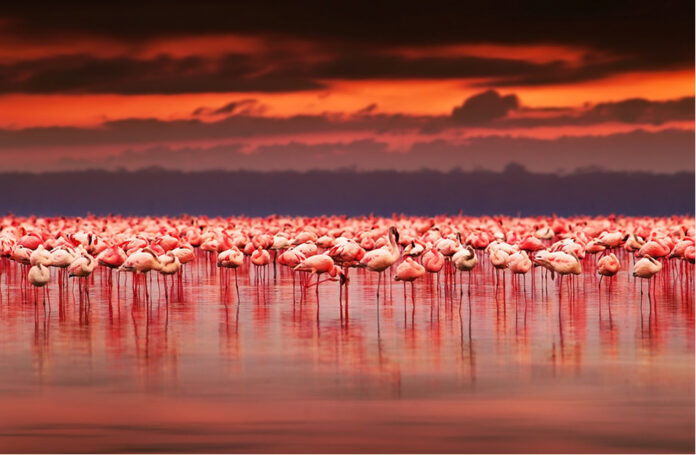The flamingo, which is the main attraction for tourists at Lake Nakuru National Park, has moved from its main sanctuary in the Rift Valley to other areas, including the minute Lake Simbi Nyaima in Western Kenya. Lake Nakuru, which local Senior Game Warden Alfred Mayoli says has lost more than two thirds of its water, is the focal point of all tourism business in town. The flamingos’ attractive colours, grace, beauty and numbers are the talk of all tourists – local and international.
Mr. Mayoli’s contention that the flamingos are migrating to Lake Simbi Nyaima and elsewhere due to drought has, however, been challenged by some experts. They argue that the birds are moving because of the contamination of water by local factories which release untreated waste into the lake.
The worrying thing about the flamingos in Nakuru is the unexplained deaths of the birds that have moved to ponds around the town’s sewage treatment plant under rehabilitation. It is believed that the birds are dying after consuming toxic waste.
In October, last year, Mr. Mayoli says, a scientist was sent to the lake to probe the cause of the birds’ deaths. The outcome of the probe is yet to be released.
A team of Japanese construction experts working on the multi-million sewerage project has declined to comment on the deaths of the flamingos at the sewage ponds. However, a worker at the site said that every morning they fill a pick-up with dead flamingos.
On the current migration of flamingos, Mr. Mayoli says it is not the first time the birds have moved. He says: “This is not the first time the lake has substantially dried up as we were faced with a similar situation in 1987. We also have recorded incidents of the drying up of the lake in the past.”
“Since flamingos are water birds”, he says, “they are definitely bound to seek a new home when there is drastic change in their physical environment”.
The deaths at the ponds, another expert argues, cannot deplete the flamingo population because they hatch in large numbers and live for long.
A bird expert from the National Museums of Kenya, Mr. Oliver Nasirwa, argues that with a life expectancy of over 50 years and an annual breeding of over 250,000 a few deaths will not make a difference since everything is being done to contain the situation.
Mr. Nasirwa observes that flamingos breed every two years at Lake Natron in Tanzania, and out of the 500,000 hatchlings more than 300,000 survive. “Considering that the average lifespan of the flamingo is 50 years the few that are dying can only be considered at this stage as normal.”
As a measure to ensure the flamingo deaths are not “abnormal” the National (Kenya) Water Fowl Census team has appealed to people to report any deaths to the nearest wildlife offices. Mr. Nasirwa agrees with Mr. Mayoli that the migration of the flamingo to places like Simbi Nyaima is nothing new.
“Considering some of the birds that went to that lake [Simbi Nyaima) when drought at Lake Nakuru threatened their existence in 1988 are still alive, it’s no wonder they have led others there”, Mr. Nasirwa said.
The bird census that was done on the shores of Lake Nakuru on January 14, drew a team of bird lovers, water fowl experts and several volunteers who with their powerful equipment counted the birds starting from 6 am to 6 pm. Tourists joined in for the love of the birds.
Friends of Lake Nakuru (FLN), a local conservation group, has noted that the reduction of the birds’ numbers posed a threat to tourism in the country.
The group’s vice chairman, Mr. Joseph Muya, attributes the decline in numbers to a reduction in the level of algae in the lake that is drying up.
During an international symposium in Portugal last September, the conservation group presented a paper on “Threats to Water Fowl and their Habitat” with reference to lakes Nakuru and Elementaita.
The symposium had been organised by Portugal’s Ministry of Environment and Natural Resources in collaboration with the International Bird Protection.
Meanwhile, scientists from Egerton University have announced that they will soon launch a Sh10 million (US$175,439) research project to establish the cause of the birds’ deaths.
A member of the team, Dr. L. A. Onek, a bio-chemist, says his team suspects that the birds are migrating to western Kenya due to the quality of Cyano-bacteria which might be deteriorating due to pollution. Cyano bacterium is the flamingos’ staple diet.
The scholar says the dominant species of Cyano-bacteria in Lake Nakuru is Spiruline Platensis.
Dr. Onek says that his team has collected samples from both Lake Nakuru and Lake Simbi Nyaima for a comparative study.
While Nakuru residents are busy speculating as to why the birds are running away from their considered natural habitat, 200 kilometres away, Simbi Nyaima people are thrilled with their new visitors.
At Simbi Nyaima flamingo “invasion” is treated with the reverence accorded a miracle. The lake itself is believed by the residents to have come into being miraculously.
Long time ago, according to local folklore, there came to Kanyadhiang Village a hungry and tired old woman called Ateku. She found the villagers celebrating – eating, drinking and dancing.
One caring woman welcomed her with food, drink, and a bed to rest her frail body.
After the magnanimous action, Ateku ordered water to spring from the ground.
Since areas adjacent to the lake are so dry, it is believed the water came into being as a token of appreciation by Ateku to the woman.
With some die-hard flamingo lovers now travelling all the way to Simbi Nyaima, 200 km away, residents of the area believe a second miracle is taking place, and treasure the event with the hope that tourism will germinate and take root in the area.
MWENYA OKHWA MUKHEBE
reporting for Safarimate









